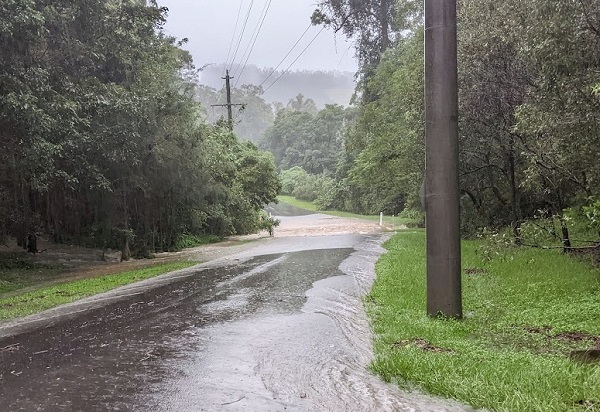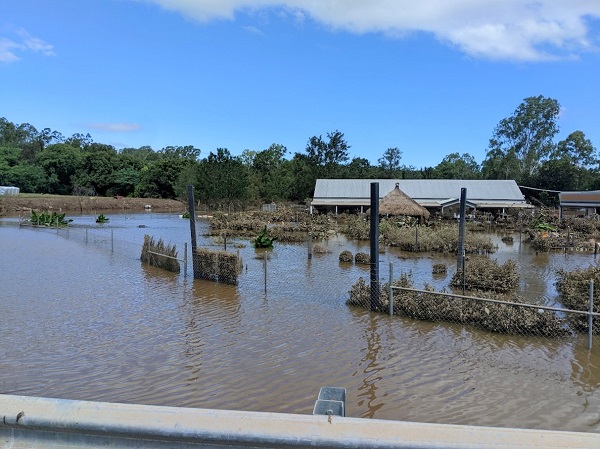 Until I find a better image of our fair city, I’ll continue to use this one.
Until I find a better image of our fair city, I’ll continue to use this one.
2022 went so fast I think I may have missed it. Still my camera says a few things happened.
Although Covid was pronounced ‘over’ we continue to take precautions, so our social life is constrained, being aged and vulnerable. I think this is the first year since I was a young child that I have not been to a movie theatre, a concert or a sporting event.
We did go to the NMQOC Inc Summer Orchid Show 2022 at the Mt Coot-tha Botanical Gardens. Here’s a sample:


My wife did continue to attend the Queensland Symphony Orchestra Morning Masterwork series once a month with her sister.
A highlight of her year was 11 May, when she was told she would no longer need to take the heavy duty antibiotics she had suffered for more than two and a half years to conquer the deep bacterial lung infection she contracted some year ago on top of her bronchiectasis. She caught the bug some years ago from the filth she encountered when working part-time in the Home Care Assistance program after leaving teaching.
I continued working on properties, or ‘yard maintenance’, so this was an early scene in my year:

Rather him than me. I was happy to supervise!
For 30 years I have been eating my lunch in the cabin of my ute without misadventure. This changed soon after the above photo was taken when I succeeded in tipping the hot coffee water down my leg into my boot. No-one heard what I said when shouting in pain!
These things tend to happen on Saturdays when normal medical assistance is limited to the public hospital emergency unit. I got some wound dressings from a pharmacy, but after the weekend there was no improvement. Then Australia Day intervened before I got help from my GP clinic. Luckily there was no infection, but the wound was spectacular.
(The draft post had the relevant photos here, before and after, but my wife assures me no-one would like to see them!)
The silver wound dressing applied by my GP clinic healed the skin in about 10 days. However, even after copious vitamin E cream I can still feel it at times.
Most will recall that in late February most of SEQ received about a metre of rain in three days.
This photo was taken on Saturday 26 February, around the midpoint of the event. I had driven in through this culvert, but when I headed home the water had risen. The water was reasonably swift, so by my judgement I would have ended up being taken to the right, where a two metre drop into a gully awaited.

So I set out to hoof it 5km back to Brookfield where there was shelter and mobile phone coverage. However, the weather was so wild my trusty rescuer says next time I can hoof it all the way home!
Actually Rafting Ground Road became problematic shortly afterwards. Days later, when the water had largely receded, this is how the Moggill nursery looked:

Then we had an election where the Liberals played it nasty, Labor played it nice:

The electors voted in the Greens candidate on Labor preferences with only 30.21% of the primary vote.
All fair and square according to the rules. However, in this representative democracy I don’t feel represented. We need to think about the Single Transferable Vote (STV) method of proportional representation, known as Hare-Clark or Mixed-member proportional representation (MMP) as used in Germany, New Zealand, South Korea or elsewhere. We can do democracy better!
Other than that the last part of the year was pre-occupied with family visits. First my daughter, grand-daughter and son-in-law came to visit from Adelaide, then my big sister and her man all the way from Toronto.
I do not have any photos of the 28 rellies we had on our back deck, and only this one when we went out to lunch with the foreigners, plus my daughter and grand-daughter, who flew back from Adelaide to see them:

Life can serve up the unexpected. This time when my sister and brother-in-law were days away from flying back to Canada my brother-in-law was hospitalised with encephalitis. The short story is that their stay has been extended by about a month and arrangements are being made for medical repatriation.
[Update 12 January: My brother-in-law was medically repatriated last Wednesday, and after a short stay in the Tritium Hospital in Toronto, is now home.]
Recovery and recuperation will take time, but we wish them good speed and a return to a rich and rewarding life of loving kindness, joy and equanimity.
Which is what we wish everyone for 2023!
I’ll finish with a few photos showing why the western suburbs of Brisbane is not a bad place to be.
Last year I showed a bonsai bougainvillea in one of the gardens I work in smothered in flowers. This is how it looked in August:

I thought it was on the way out, but here it is in December:

Then in the dusk, visitors:

Back at our place we have wild life too:

And a piece of paradise, only 7km from the GPO as the crow flies:

So we look forward to 2023, which surely will be more congenial and better than 2022!

The latest New Scientist has a cartoon in the Back Pages.
In the first frame a middle-aged balding man says:
And so we begin another orbit of our sun: a star that will heat and grow until, long after we are dead, it swallows the earth, then dwindles away as the universe coldly proceeds to the end of all time.
The second frame shows that he is in fact at a party where people are paired off chatting to each other with wine glasses in hand. The woman he is talking to replies:
I wish you’d just say “Happy new year”, Harold.
Happy New Year Brian!
Thankyou, John, and to you and yours!
Some times I miss living on the side of Mt Coutha and the joy I would have had when the Greens won Ryan.
BTW, the Greens have traditionally favoured systems like Hare-Clark or Mixed-member proportional representation (MMP) as used in Germany, New Zealand, South Korea or elsewhere.
John, I know the Greens have electoral reform on their agenda, and I wish they would spend energy on advocating things that matter rather than utopian dreaming that we can just tax the rich and have anything that any progressive would wish for.
They did not run on climate, because they did not have to.
I know they have been gaining traction as Brisbane gentrifies with people of substantial means but not super-rich, so not Teal territory.
Sorry I haven’t been impressed with the quality of candidates elected so far. That includes our now local member Elizabeth Watson-Brown.
Apparently Drew Hutton said late in 2021:
he feared the party had “locked themselves into a middle class, inner city, tertiary educated, identity politics-driven ghetto”
So we’ll end up with Greens in Brisbane and maybe Gold Coast and Sunshine Coast, and LNP in the provinces.
That quote was from an article by Paddy Manning Inside Queensland’s green wave . It’s certainly worth a read if you can bust inside the pay-wall. Padding talked to a lot of people.
Some see the whole country pivoting politically on what happens in Brisbane, so be warned!
A tweet from Simon Holmes à Court posted yesterday (Jan 1), including graph:
https://twitter.com/simonahac/status/1609393485907644417
If that trend continues, RE will overtake coal within the next few years as the single biggest energy source for electricity generation in the NEM.
Happy New Year 2023!
Brian: You seem to be a bit bitter and twisted about the Qld Greens. Yep, they are the party of the educated middle class and are a logical match for Ryan. Yep, I don’t always agree with them but at least they are not claiming that we cannot afford to do something for the people at the bottom of the pile because they are committed to cutting the taxes of the rich.
They are also becoming more experienced in governing. NSW has had Green Mayors for some time. It makes a difference. (I remember the first discussion I had with a Green lord mayor. What he was talking about was the need for another pot hole repairing unit.)
Had a look at your link but couldn’t see what you thought was wrong with your new green federal member.
Geoff, I looked at his source and could not find the graph. However, I found this one:
Simon Holmes à Court’s graph seems to show too much gas, which is orange in the one I’ve posted. Any way the last 7 days shows renewables at 41.9%. You are right, it won’t be long before they are the majority.
On reflection, gas is probably always less than about 10% in the graph. It was never a candidate for a ‘transition’ fuel.
John, Elizabeth Watson-Brown is one of the better Greens candidates. It’s just that if you had heard Peter Cossar talk about why he wanted to go into politics, there is no comparison.
Watson-Brown’s first speech is here. If you were being cynical you might say that she had retired, did not have much to do, and by her own account:
it was the arrival of grandchildren: “No longer content to yell at the television during the nightly news, I joined the Greens and took to the streets of Ryan.”
that got her interested in parliament.
We’ll see.
I’m not bitter and twisted about the Greens. However, I think we need structural change in our political system if civility and a contest of ideas are to be achieved. The Greens are more interested in playing a short-term political game within the present structure.
It’s a shame.
The way things have turned out, I suspect we’ll get more from David Pocock than from 16 Greens.
Or as much.
Brian: ” However, I think we need structural change in our political system if civility and a contest of ideas are to be achieved.
I seem to remember that the Labor party was the source of: “It is nice to be right but it is better to have the numbers.” (Better to have the power to make things happen than be squeaky clean on policy.)
Pockock is doing a good job but I think he would be struggling if there were no elected Greens.
Meanwhile, it seems US-origin COVID ‘super-variant’ XBB.1.5 is spreading globally very fast, per Eric Feigl-Ding tweet thread today (Jan 3).
Why is XBB.1.5 a ‘super-variant’? Because it’s:
Among most immunity-evasive ‘escape variants’ to date;
One of the best variants for invading human cells via ACE2;
Spreads much faster than old XBB or BQ;
Causes rising hospitalizations wherever dominant (e.g. NY, CT, MA, NJ).
It seems the US CDC entity failed to report for weeks that XBB.1.5 was surging in the USA.
https://covid.cdc.gov/covid-data-tracker/#variant-proportions
Latest weekly (IMO, should reinstitute daily) data indicates NSW hospitalizations are still rising: https://twitter.com/crudeoilpeak/status/1608600395366162433
Here we go again! When will people learn?
Some COVID stats for Australia, per covidlive:
2020: Cases: _ _ _ 28,408; Deaths: _ _ 909
2021: Cases: _ _ 367,096; Deaths: _ 1,330
2022: Cases: 10,734,779; Deaths: 14,813*
Year 2022 is an extrapolation of the data as at 30 Dec 2022.
For perspective, leading causes of death in 2019 in Australia (before COVID emerged):
#1 Ischaemic heart disease: _ _ _ _ _ _ _ _ _ _ _ _ _ _ _ _ _ 18,244
#2 Dementia, including Alzheimers: _ _ _ _ _ _ _ _ _ _ _ 15,016
#3 Cerebrovascular diseases: _ _ _ _ _ _ _ _ _ _ _ _ _ _ _ _ _9,891
#4 Malignant neoplasm of trachea, bronchus & lung: 8,821
#5 Chronic lower respiratory diseases: _ _ _ _ _ _ _ _ _ _8,372
#6 Malignant neoplasm of colon, sigmoid, rectum & anus: 5,410
#7 Diabetes: _ _ _ _ _ _ _ _ _ _ _ _ _ _ _ _ _ _ _ _ _ _ _ _ _ _ _ _ _4,967
#8 Malignant neoplasms of lymphoid, haematopoietic & related tissue: 4,793
https://www.abs.gov.au/statistics/health/causes-death/causes-death-australia/2019
Per ABS on Provisional Mortality Statistics:
https://www.abs.gov.au/statistics/health/causes-death/provisional-mortality-statistics/latest-release
IMO, if we allow it, COVID will likely substantially erode human life expectancy. I suspect people living into their 70s & beyond could become very rare in future, particularly if people acquire multiple re-infections of COVID.
Thanks for the warning Geoff. People seem to be assuming the problem has gone away.
Thankyou, Geoff. I’ve been worried by what I hear and see. Some months ago my brother told me it was mostly old people dying from Covid, more men the women dying and average age of death was my age.
Seems we don’t matter.
If the excess deaths you quote are correct (roughly 20,000 in 9 months) then that’s around 500 per week.
Here’s an Australian Government Health and Aged Care site Coronavirus (COVID-19) case numbers and statistics.
The stats taper down at the end with a dotted line. I suspect that means they have gone on holidays and don’t know what’s happening yet.
Hospitalisation and medicine-taking is clearly increasing. Aged care homes are a concern.
Then I checked out OzSAGE. Here are their last four media releases:
Australia – For a better 2022 Festive Season, suppress COVID-19!
They have 13 sensible recommendations at the end, which would not cost an arm and a leg.
Second:
OzSAGE submission for the Inquiry into Long COVID and Repeated COVID Infections – Parliament of Australia
There are problems of definition and sourcing accurate data, but it could be 15% of Covid cases, or double that.
The main symptoms are fatigue, which can be extreme, respiratory issues and brain fog.
High levels of infections and reinfections will lead to impacts on workforce, reduced life expectancy and diminished quality of life due to long COVID and post-COVID health problems.
Then OzSAGE sent an Open Letter to National Cabinet .
Oh dear!
Seems that until October 2021 we were world champions at dealing with Covid. Now we have fallen behind NZ, Japan and Thailand.
Indeed we seem to be trying hard to make things worse by copying bad practice from elsewhere, adopting practices which have been tried and shown to fail. Much of it is just wrong-headed and wrong according to this bunch of experts. It is based on misperception and wishful thinking at best. Eg:
For the risk profile to state that ‘the crisis phase has passed and the risks of widespread COVID-19 deaths, overwhelming health system capacity and a significant economic shock from COVID-19 have subsided’ is false and unconscionable, given the high numbers of cases, workforce shortages, hospital admissions resulting in cancellations of elective surgery, ambulance ramping and significant ambulance response delays, direct and indirect COVID-19 deaths we continue to experience. (Emphasis added)
Finally:
OzSAGE says “avoid decking the halls with COVID-19 folly”.
OzSAGE recommends the public health precautions contained in their Vaccine-Plus strategy, and:
This one shows the graph of our failure from October 2021.
That took a lot of fiddling with the format. Don’t try it at home!
Thanks Brian.
IMO, OzSAGE’s submission #299 for the ongoing Parliament of Australia House of Reps Standing Committee on Health, Aged Care & Sport Inquiry into Long COVID and Repeated COVID Infections provides some very sobering observations worth repeating (bold text my emphasis):
1) At a minimum, 4% of vaccinated people who have a breakthrough infection will experience symptoms lasting for three months or longer. More credible estimates, repeated in several studies, are around 15%, with high estimates over 30%. The incidence of long COVID is higher in unvaccinated people, and reinfection increases the risk.
2) The extent of protection remains uncertain, with estimates ranging from 15 to 41%, indicating less than half of cases of long COVID are prevented through vaccination. A vaccine-only pandemic strategy is insufficient to protect Australians from long COVID and repeat SARS-CoV-2 infections, particularly when, without action, high numbers of infections will continue to occur.
3) In addition to the risk of developing long COVID, people infected with SARS-CoV-2 are at significantly higher risk of serious cardiovascular and metabolic complications, including heart attack, stroke, diabetes, and kidney disease, as well as damage to the nervous and immune systems. There is credible evidence that the risk of experiencing these outcomes increases with repeat infections. Infection during pregnancy may have adverse outcomes for both mother and baby.
6) SARS-CoV-2 will continue to circulate into the foreseeable future. Australia will experience ongoing waves of COVID-19 due to the winding back of strong preventive and isolation measures, waning vaccine efficacy, suboptimal booster rates and immune evasion. High levels of infections and reinfections will lead to impacts on workforce, reduced life expectancy and diminished quality of life due to long COVID and post-COVID health problems.
I think governments at all levels are in denial of the accumulating compelling evidence/data, and through their collective wishful thinking and many bad decisions, aided and abetted by many ill-informed & ideologically-driven media commentators, our society is at increasing risk of being steadily eroded by an increasingly debilitated population.
Geoff, exactly.
On another matter, on environment law reform, it seems self-evident to me that the minister for environment in considering development proposals, has a duty of care to future generations.
I do mean self evident. It does not require lengthy legal/philosophical justification. On Tuesday I listened to Dr Frances Flanagan- Lecturer in Work and Organisational Studies University of Sydney on ABC RNs Big Ideas:
Without serious action by 2025 the planet is set to warm beyond one and a half degrees.
That’s the unequivocal assessment of the Intergovernmental Panel on Climate Change.
To reach the target, the IPCC says that governments should not approve more fossil fuel projects yet in Australia we continue to do so.
A social scientist says our environmental protection laws need to be redesigned to give greater weight to the protection of future generations who’ll face the full impact of climate change.
Horizons of National Responsibility- law and the protection of life on a fossil-rich continent recorded 31 May 2022 Australian Academy of the Humanities Hancock Lecture
First broadcast 28 June 2022
Environmental laws to tackle climate change
I’m wondering whether our signing up to The United Nations Convention on the Rights of the Child obligates us to to have duty of car for future generations.
Brian: “I’m wondering whether our signing up to The United Nations Convention on the Rights of the Child obligates us to to have duty of car for future generations.” Yep, youngest grandchild is 4 yrs old = 81 by 2100.
Indeed, John, but I’ve just checked it out:
United Nations Convention on the Rights of the Child
It’s surprisingly present-oriented. No doubt the continued existence of living planet was taken for granted.
It seems estimates of last year’s global average temperature anomaly are due to come out sometime in this coming week.
Andrew Dessler has made it easy for reporters with this tweet posted Jan 7.
It seems the pattern for James Hansen & team’s report on the previous year’s global average temperature anomaly is due around Jan 13-18.
Thanks for the heads-up, Geoff. When Hansen’s update comes out I’m hoping to do a new Four graphs that matter.
Meanwhile, the Wood Mackenzie site has been recommended to me as a mob that has good information on the energy industry. I think they probably do, but I found these two articles hair-raising:
Ten predictions for 2023
Silver linings playbook: Five reasons to be cheerful
If they are on the money about what is going to happen, then we are cooked!
It’s worth getting access to the current edition of The Saturday Paper, where Karen Middleton reports on Jane Halton’s latest review of COVID strategies and policies in Exclusive: Halton report warns of repeating Morrison errors .
She warns that the Commonwealth government does not appear to be renewing contracts to supply new vaccines or take appropriate action to see that anti-viral medicines are available to those who need them.
They need to have a story and apparently don’t.
Speaking to The Saturday Paper this week, Halton emphasised that the virus remains a serious threat that could worsen.
“The world is currently seeing the emergence of yet more new variants, including XBB1.5, which underscores that the pandemic and particularly the effects of SARS-CoV-2 are not yet completely behind us,” said Halton, who heads the global Centre for Epidemic Preparedness Innovations, or CEPI.
“The entire world is looking forward to a day where we don’t have to worry about SARS-CoV-2. However, we continue to need to be prepared for all circumstances, including new and more dangerous variants.”
In her report, Halton writes that Australia signed advanced purchasing agreements (APAs) with vaccine manufacturers “later than other comparative countries which delayed the supply of vaccines and the speed of the rollout”.
Australia later overtook other countries, once a distribution plan was in place. However, Halton warns that those foundational APAs are now expiring. “As a consequence, new APAs giving effect to purchasing decisions will be needed.”
Australian Medical Association president Professor Steve Robson :
“It’s really important to take a step back and say, ‘What are we trying to achieve here?’ I’d love to see a narrative from the federal Health minister – the goals we want to achieve. I’m just not seeing that. It just seems to be a lot of Whac-A-Mole going on.”
Thanks Brian, a whole lot of whack-a-mole indeed, and ignoring what evidence/data indicates best works to reduce transmission – effective mask wearing, distancing, ventilation, test, trace, isolate.
Meanwhile, ICYMI a US federal safety agency is considering a ban on gas stoves amid health fears.
Watch the pushback from the gas suppliers.
Federal government to lower emissions ceiling on biggest polluters by 4.9 per cent each year till 2030Wonder what happens at the end of the 7 yrs?
RenewEconomy and Green groups not impressed by the latest batch of government proposals to reduce emissions. See: ““Coal truck-sized loopholes” loom as Labor floats Safeguard Mechanism reforms“
Brian: The Conversation: “Labor’s scheme to cut industrial emissions is worryingly flexible“.
What are your views Brian?
John, I would hope to elaborate on this, but James Hansen told us in 2007 in his Bjerknes Lecture to the American Geophysical Union (see Hansen J Climate Threat to the Planet, American Geophysical Union, San Francisco, California, 17 December 2008,) that we needed in the first instance to reduce CO2 concentrations to 350ppm. We were at 386ppm at the time.
At that time it looked doable.
What we’ve done is shown here.
Please note that what is shown at Mauna Loa is the airborne fraction that matters. There was no pause for Covid. Climate Tracker’s graphs are compiled on national accounting figures, which are bound to be wrong, and include the half or more of emissions that end up being absorbed by the ocean or on land.
Tim Flannery in his book The Climate Cure , published around May 2000, pointed out that to reach zero emissions we would have to reduce at the rate of about 8% a year, then drawdown if we want to avoid tipping points and minimise ice sheet decay. Tipping points start at 0.8°C of warming (Greenland) and in terms of risk we should try to stay well clear of that, so the aim should be 0.5°C not 1.5°C, which offers false hope.
So many tipping points are already activated that stability appears unlikely at 1.5°C. It was always a political compromise rather that a goal based on science.
Flannery points out that to drawdown 1ppm of CO2 requires 18 billion tonnes to be taken out of the atmosphere and placed where they will stay at least 100 years. Trees are hopeless because they are threatened by drought, insect attack, land-clearing and fire, also require too much land, grow too slowly and in some places sequester less carbon than open savanna.
In reference to the Wood Mackenzie articles I linked to, gas corporates falsely see themselves as an interim technology, thus part of the solution. Coal corporates see themselves as carrying on through buying offsets and assume that CCUS is going to allow them to do so.
Prof Kevin Anderson says that offsets should be used only where absolutely necessary, as in food production and should be molecule for molecule with carbon storage instantaneous and secure. He reckons about 8% of all emissions.
No-one should be paid for avoiding emissions, such as not clearing land they never intended to clear.
So the whole thing gives me the heeby jeebies. Offsets are basically people paying to continue bad behaviopur. I do agree, however, that it is worse than pointless to offshore emissions-generating activities, then import the goods produced. Too much of the OECD emissions reduction claims come through this lurk.
Most climate scientists lack the ‘earth systems’ knowledge to understand the whole deal, and most greens are seduced by their love of trees, which I too love, in their place.
Apart from that what is being proposed has one giant flaw. It’s based on net zero by 2050. James Hansen understand better than anyone what’s going on with temperatures. 1.5°C by 2030 and 2°C around 2040 or soon after are pretty much baked in. If we happen to reduce emissions we’ll be caught by reduced aerosols, what Hansen calls our Faustian bargain (Faust sold his soul to the devil in exchange for wealth and a good time). Clouds are not measured or understood and seem to be working against us. Heat is not mixing as deep in the ocean as expected, and can come out through more rain in the cryosphere, El Niños and such.
There are the companies that:
1. Extract fossil carbon from the earth.
2. Damage forests etc. that act as carbon sinks.
3. Run businesses that release Greenhouse gases into the atmosphere.
4. Run businesses that demand population growth to help their profits grow.
More emphasis needs to be put on the human plague, the damage they cause and the harder they make it to do something to reduce the impact of climate change on people and the environment.
Here’s the Independent Review of Australian Carbon Credit Units. It’s open for comment until 24 February.
Andrew Macintosh and Don Butler of the ANU say Chubb review of Australia’s carbon credit scheme falls short – and problems will continue to fester. They reckon that the report did not seriously deal with the problems they found.
The Climate Council reckon that the Chubb Review misses the emissions elephant in the room – there is no limit on the offsets that can be used.
Adam Morton and Peter Hannam at The Guardian have produced two detailed and fair articles with a roundup of comment:
Chubb review recommends new integrity body for Australian carbon credits scheme
Can’t post the second as I’m getting “internal server error’ !
It’s clear that new coal and gas initiatives are enabled by the scheme.
Bowen says the Government has accepted all recommendations. It seems to me that this will necessitate amending legislation.
I’ve just reread the post, and discovered I’d left out this image of the flooded road:
Not much, you might think, but I still think I would have ended up in the ditch!
Australia’s big polluters must cut emissions by nearly 5% a year, but can use offsets to get there
There’s the second link. Now it likes me, but I’m not impressed!
Brian: I get the impression that Bowen is not really committed.
What we really need to do is keep the fossil carbon in the ground and, if possible add to the amounts in stable storage.
Offsets like planting trees that will rot or burn are not a reliable, let alone long lived alternative.
Then there are issues associated with steel, etc. production.
From the Copernicus Climate Change Service (C3S), dated 9 Jan 2023, summary begins:
https://climate.copernicus.eu/copernicus-2022-was-year-climate-extremes-record-high-temperatures-and-rising-concentrations
John, I think Bowen is a smart politician and is walking the path of the politically possible. Sometimes he hints at his real view in an aside during a meeting or presentation. I think he understands the science as well as anyone in the parliament.
I’d like to hear someone talking about the inadequacy of net zero. ‘Beyond zero’ and 350ppm have slipped from the lexicon.
The Greens have a new Climate platform with a suite of policies (didn’t see it before the election) and a more detailed plan – Powering past coal and gas.
They say:
The Greens climate targets are for a 75% reduction on 2005 levels by 2030 and for net-zero emissions by 2035. We then go further and aim to be a net-negative emissions economy with over 100 million tonnes of net drawdown every year by 2050.
I’d like to see them say why we must go beyond zero, and why 100 million tonnes is appropriate. Flannery’s latest climate book says 18 billion tonnes world-wide is needed to take one ppm out of the atmosphere. Per annum that’s about half what we burn in fossil fuels at present.
Geoff, thanks. Here’s the graph:
And here’s 2022 air surface temperature anomaly, compared to 1991-2020:
Looks like La Niña kept us a bit cool.
Scientists have also found that ocean heat keeps on rising.
People don’t seem to understand that this will keep happening, though perhaps not as fast, if we get to net zero.
Brian: – “Scientists have also found that ocean heat keeps on rising.”
Glaciologist Prof Jason Box tweeted 29 Dec 2022:
The only way to reverse this process is for ‘negative’ GHG emissions, reducing atmospheric GHG concentrations (carbon dioxide + methane + nitrous oxides, etc.) to well below 350 ppm (carbon dioxide equivalent, NOT just CO2). This needs to happen before the Earth System breaches the +2 °C warming threshold, otherwise the ocean heat content build-up is likely too much to prevent complete ice sheet loss.
ICYMI, James Hansen & colleagues at the Columbia University’s Earth Institute published their latest communication, dated 12 Jan 2023, beginning with:
Their ranking of the tenth warmest years in the instrumental record, based on GISS temperature analysis:
#_1 _ 2020 _ +1.29 °C (relative to 1880-1920 global mean)
#_2 _ 2016 _ +1.28 °C
#_3 _ 2019 _ +1.24 °C
#_4 _ 2017 _ +1.19 °C
#_5 _ 2015 _ +1.165 °C
#_5 _ 2022 _ +1.162 °C (essentially equal with 2015)
#_7 _ 2021 _ +1.12 °C
#_7 _ 2018 _ +1.12 °C (equal with 2021)
#_9 _ 2014 _ +1.01 °C
#10 _2010 _ +0.99 °C
https://www.columbia.edu/~jeh1/mailings/
Will this year, 2023, be around equal warmest on record?
Will next year, 2024, be “off the charts”?
We’ll see soon!
Thanks for that, Geoff. You have impressive coverage of climate scientists Tweets.
Hansen has just delivered on 2022 temperature:
Global Temperature in 2022
Global surface temperature in 2022 was +1.16°C (2.1°F) in the GISS (Goddard Institute for Space Studies) analysis1,2,3 relative to 1880-1920, tied for 5th warmest year in the instrumental record. The current La Nina cool phase of the El Nino/La Nina cycle – which dominates year-to-year global
temperature fluctuation – had maximum annual cooling effect in 2022 (Fig. 1). Nevertheless, 2022 was ~0.04°C warmer than 2021, likely because of the unprecedented planetary energy imbalance (more energy coming in than going out). The already long La Nina is unlikely to continue, tropical neutral conditions are expected by Northern Hemisphere spring, with continued warming as the year progresses. Thus, 2023 should be notably warmer than 2022 and global temperature in 2024 is likely to reach +1.4-1.5°C, as our first Faustian payment of approximately +0.15°C is due.
It’s useful to consider this piece in the context he paints in Global warming in the pipeline and Earth’s Energy Imbalance and Climate Response Time.
Thanks, Geoff. Cross-posted.
Brian: Part of the problem is that when an average person sees something like : “#_1 _ 2020 _ +1.29 °C (relative to 1880-1920 global mean)” they will be inclined to say “so what” given that the temperatures they experience over the day and year are much greater than that. How do you convince people there is a crisis that justifies the way they live?
John D: – “How do you convince people there is a crisis that justifies the way they live?”
Re consequences of our current GHG emissions trajectory, I’d suggest for starters looking at Table 1: Consequences of Global Warming at Different Levels in the expert report by Dr Penny D Sackett (former Australian Chief Scientist from November 2008 until March 2011) to the NSW Independent Planning Commission re the Mt Pleasant Optimisation Project SSD 10418.
https://www.ipcn.nsw.gov.au/projects/2022/05/mt-pleasant-optimisation-project-ssd-10418
Click on the “Public Submissions” tab, scroll down & expand the “Email & Postal Public Submissions” section, then scroll down to find Attachment A Sackett Report Climate Change Impacts_Redacted (22.07.2022, pdf 19.7 MB).
And look at the transcript of Prof Sackett’s presentation. Click on the “Meetings” tab, expand the “Public Hearing” section and download the Day 2 transcript, from pages 4 through to 8.
A video of Prof Sackett’s public hearing presentation (duration 0:15:53) is available at:
https://www.facebook.com/Lock.The.Gate.Alliance/videos/mount-pleasant-professor-penny-sackett/991856604838969/
The Laws of Physics are at play.
Who would have thought it? Exxon Mobil predicted global warming with ‘astonishing accuracy’ while publicly denying climate change, report finds
Seems unlikely that Mobil was an island.
Geoffrey Supran, the lead author of the Science paper published 13 Jan 2023, titled Assessing ExxonMobil’s global warming projections, tweeted a thread yesterday (Jan 13) to highlight some of the paper’s findings.
Alexandria Ocasio-Cortez asks former Exxon scientists about oil giant’s climate change denial, in Oct 2019, duration 0:03:52
https://twitter.com/independent/status/1187719206562910209
In terms of how much longer key people might expect to live CO2 driven global warming is quite slow. Key people would be tempted to keep quiet, wait and see rather than shut down their fossil fuel business right now.
From Supran’s Twitter thread:
Exxon’s average projected warming (0.20° ± 0.04°C per decade) was, within uncertainty, the SAME as that of independent models (0.19° ± 0.03°C per decade).
They knew what was happening with climate. How can we trust them now?
Penny Sackett’s submission is impressive.
Her account of irreversible changes (Section 2.8) and Chapter 5 on current impacts and possible futures should convince anyone with half a brain that we need to take drastic action to avoid a climate catastrophe.
Some minor gripes.
In Figure 7 (page 31) she uses the global Carbon Tracker graph for fossil fuel production. As I’ve said earlier, these appear to be based on national reporting, so are wrong in terms of airborne CO2.
She under- does sea level rise, as she is drawing from IPCC stuff. However, she does warn that it will go on for centuries to millennia even if we stabilise CO2 emissions.
However, it’s 11 out of 10 standard, ie better than one would expect. She should be on the Climate Change Authority.
Many would argue that the UNFCCC annual COP (Council of Parties) process has become farcical. At COP 27 in Egypt there were 600 fossil fuel lobbyists present. Now for COP28 in the United Arab Emitrates a senior oil man has been appointed to lead the talks:
Climate campaigners reacted with outrage on Thursday to the announcement that the United Arab Emirates’s president has appointed the leader of the country’s national oil company to preside over the 2023 United Nations climate talks, which the UAE will host later this year.
Sultan Ahmed Al Jaber was named as president-designate of this year’s UN climate summit, COP28, scheduled to take place November 30 – December 12 in Dubai. Al Jaber is the UAE’s special envoy for climate change and also serves as the country’s Minister of Industry and Advanced Technology. He is the founder and CEO of a renewable energy firm called Masdar. But it is his role as the CEO of Abu Dhabi National Oil Company (ADNOC), one of the largest oil and gas producers in the world, that is sparking condemnation and conflict of interest allegations.
“You wouldn’t invite arm dealers to lead peace talks. So why let oil executives lead climate talks?” Alice Harrison, fossil fuels campaign leader at Global Witness, said in a statement.
“Renewable energy is now cheap and abundant,” Harrison continued. “But fossil fuel companies are working hard to keep skin in the game, and sadly the UN is rolling out the red carpet to them. This blatant conflict of interest at the heart of this year’s climate talks threatens to torpedo them before they’ve even begun.”
Whatever the final place of hydrogen in the energy system (Saul Griffith sees it as occupying a 5% niche) it is being pushed heavily at present, as this article finds:
Green hydrogen: why low-carbon fuels are not benefiting from high fossil fuel prices
The number and scale of projects using and making hydrogen, a gas that releases energy when burned without emitting carbon dioxide, is rapidly growing. If its construction goes to plan, a €2.5 billion (£2.18 billion) undersea pipeline will convey “green hydrogen” from Spain to France from 2030.
In the US, some power stations are being upgraded to allow hydrogen to be blended with fossil gas, and the Norwegian oil company Equinor is teaming up with Thermal SSE to build a 1,800 megawatt (MW) “blue hydrogen” power plant in Britain.
Meanwhile, China unveiled a plan in March which includes deploying 50,000 hydrogen vehicles by 2025 and early December saw the first hydrogen-fuelled tractors and forklifts leave the assembly line at a new plant in Guangdong province.
Astonishingly:
only 0.04% of hydrogen is green, and blue hydrogen is less than 1%. The rest is grey or brown, most of which is used in oil refineries and for manufacturing ammonia and methanol. It’s an enormous industry which emits more CO₂ than all of Britain and France combined.
They say:
while the buzz around the hydrogen economy intensifies, a closer look suggests the fuel is less a spearhead for a green transition and more the subject of an elaborate bait-and-switch operation by oil companies.
In fact:
fossil-fuel firms are rebranding themselves as agents of “carbon management.” The aim is to prevent their assets from getting stranded by repurposing them, presenting a largely fictional substance, blue hydrogen, as a low-carbon “bridge” to an unspecified green future.
Meanwhile:
the high price of oil and gas has turbocharged the industry’s expansion. The US government is exhorting oil and fracking firms to “drill baby drill”. Britain’s government is to award more than 100 licenses to drill for oil and gas and colossal new fossil fuel investments have been announced across the Middle East and Africa.
In a few years when these new sources come onstream, and particularly if economic growth continues to slow and depress energy demand, gas and oil will become cheaper again – until the next price spike prompts new rounds of investment, and the infernal cycle continues. The owners of newly-built wells, pipelines and terminals will fight to defend those assets and stall decarbonisation.
The authors say hydrogen can form a useful part of our energy future, but public policy should guide its development. Then there is the issue of water:
If green hydrogen production is scaled up to play a significant economic role by 2050, its freshwater demand will exceed one-quarter of today’s global annual consumption, risking water scarcity in some regions.
Giant floods notwithstanding, available and usable freshwater will be more scarce in the Anthropocene.
Hydrogen will have to leap a significant hurdle – round trip energy efficiency – to compete with other long-duration (i.e. several hours through to multi-day) energy storage options:
https://www.spglobal.com/marketintelligence/en/news-insights/latest-news-headlines/hydrogen-technology-faces-efficiency-disadvantage-in-power-storage-race-65162028
Large-scale battery energy storage systems (BESSs) are now the superior choice for electricity peaking services (for up to several hours of storage capacity) providing significant cost, flexibility, and emissions advantages when compared to equivalent open-cycle gas turbine plants.
https://www.cleanenergycouncil.org.au/resources/resources-hub/battery-storage-the-new-clean-peaker
Geoff: Solar thermal has potential advantages for power generation and energy storage. Storing solar heat in molten salt is relatively straight ford and does not depend on exotic minerals. Gas, oil or biofuels can easily be used to heat the molten salt during long periods without sunlight.
John D: – “Storing solar heat in molten salt is relatively straight ford and does not depend on exotic minerals.”
And yet few are investing in the technology. Costs may have something to do with it – see the CSIRO’s latest draft consultation for GenCost, published 16 Dec 2022 at:
https://www.csiro.au/en/news/news-releases/2022/gencost-report-finds-renewables-increasingly-important-as-technology-costs-surge
ICYMI, The Guardian published an article yesterday (Jan 17) by Damian Carrington headlined Warning of unprecedented heatwaves as El Niño set to return in 2023. It included:
Hansen & colleagues included in their communication (posted 22 Sep 2022) linked in The Guardian article – but you have to go look for it yourself – contained Fig. 3. Global surface temperature relative to 1880-1920 mean. The graph included global mean surface temperature ‘predictions’ for years 2022, 2023 & 2024.
It seems some of the mainstream media are starting to wake-up and inform their readership! But it seems to me there is some information Damian Carrington (or perhaps his editor) doesn’t wish to highlight – still no mention of the Hansen et. al. pre-print paper Global warming in the pipeline, either referenced in the communication by Hansen & colleagues at Columbia University on 13 Dec 2022, or at arXiv.
What I liked about solar thermal with molten salt is that it could operate over long cloud cover because of the turning on the molten salt heater. However, it is years since I have thought much about it so could be well out of date.
BZE was pushing solar thermal years ago but it is a long time since I have read any BZE stuff.
Geoff, I too was surprised he linked to a statement 6 months old, when there was more relevant recent statements.
There was an interesting post by Gavin at RealClimate on the temperature updates highlighting the role of ENSO.
John, you probably saw Parkinson at RenewExconomy:
Fossil fuel crisis prompts biggest ever switch to renewables and storage in 2022
Pumped hydro is getting some interest, which is good to see.
Brian: As you are aware I have been a long time supporter of renewable ammonia as part of the energy mix, particularly for transport. Unlike clean methanol it does not need CO2 to manufacture and all the raw materials are available everywhere.. Nor does it need lithium.
Hence my interest in : “World’s first ammonia-electric semi packs as much energy as the Tesla.”
Revealed: more than 90% of rainforest carbon offsets by biggest provider are worthless, analysis shows
https://twitter.com/dpcarrington/status/1615732738140561409
ICYMI, posted on YouTube 14 Nov 2022 by Nick Breeze ClimateGlenn was a video titled Prof. Jason Box – Zombie Ice and unforeseen sea level rise, duration 0:12:50. In this ClimateGenn episode, Nick Breeze speaks with Professor Jason Box about his recent research that identifies the amount of Greenland’s ice sheet that is committed to melting in the coming decades.
0:03:39: “…by end of century, we are talking, you know, just from Greenland, at least fifty centimetres of sea rise…”
0:04:18: “…You know, so by mid-century, end-of-century, we’re probably going to be facing much bigger numbers.”
https://www.youtube.com/watch?v=HrdMOFXuXlc
And: Greenland temperatures the warmest in more than 1,000 years, new data show
Thanks for the above. Have to rush, but there is a lot to keep up with.
Meanwhile our major companies are choosing a future for us which they think will benefit them:
Fossil fuel interests revealed to have sponsored more than 500 Australian community organisations
Brian: It is pretty normal for mining and other companies to contribute to communities. It helps make isolated communities better places to live and generally improves community/company relationships by helping to provide things that people in big cities take for granted.
My concerns are significant contributions to political parties or influential organizations.
The conversation: China’s population is now inexorably shrinking, bringing forward the day the planet’s population turns down
Serious population shrinking will help the future.
A YouTube video by a climate scientist with the British Antarctic Survey, Dr Ella Gilbert on reviewing 2022: a big year in climate, duration 0:13:39.
https://www.youtube.com/watch?v=qk560NltNLg
Posted at abc.net.au yesterday (Jan 21) was Laura Tingle’s piece headlined COVID is still wreaking havoc across Australia but political and medical debate seems to have succumbed to pandemic weariness. It begins with:
Check out her interview with the federal Minister for Health, Mark Butler, on ABC TV’s 7:30 program on Jan 17.
It seems as far as I can see Laura Tingle is perhaps the only person talking and writing in the Oz MSM about this.
Pretty much, that is the case, Geoff. I listen to a lot of ABC RN and NewsRadio. I’ve heard a few interviews, invariably expressing concern.
There has been a lot of positive comment on Twitter about Tingle’s interviewing style, ie. treating people with respect, asking sensible, penetrating questions, and not looking for ‘gotcha’ moments.
Geoff, there was a significant segment on 7:30 Report last night, which you probably saw. Laura Tingle with Bernard Crabb as epidemiologist, a doctor with long Covid and Richard Dennis on economic impact.
The workforce impact is about equivalent to our skilled immigration program.
A new Pfizer vaccine was approved recently, but will the Government roll it out?
On climate, there is a comprehensive report at CarbonBrief State of the climate: How the world warmed in 2022 showing accelerating trends in everything that matters – emissions, temperature, ocean heat, sea level rise etc.
7:30 Report story on Covid.
OzSAGE media release on death rates (download the graphic).
US petroleum geologist Art Berman tweeted on Jan 18:
The quality of oil is declining.
That means there’s less energy content per volume of oil produced.
That means less net energy available for economic activities.
A YouTube video published by Nate Hagens on 18 Jan 2023 titled Arthur Berman: “Peak Oil – The Hedonic Adjustment” | The Great Simplification #54, duration 1:09:00, is linked below, where Art explains how our institutions have redefined what is considered oil, which has created an illusion of constantly growing oil production. The reality is that – circa 2023 – fully 40% of what is called oil is comprised of things that are ‘not oil’. What does this imply for global peak oil?
There are show slides & transcript available in the YouTube video notes.
https://www.youtube.com/watch?v=CDBJdQnjE2o
And yet it seems governments, businesses & the media are behaving as if petroleum fuels will remain ABUNDANT & AFFORDABLE to meet society’s needs into the future.
Global diesel/gasoil fuel production has been declining since the peak in 2015-18 at circa 26 Mb/d, before the pandemic & before the Russian invasion of Ukraine.
https://crashoil.blogspot.com/2021/11/el-pico-del-diesel-edicion-de-2021.html
I’d suggest it’s likely that the global production of kerosene/jet fuel is the next petroleum product to begin a decline as heavier crude oils with the necessary longer-chain hydrocarbon molecules become increasingly scarcer.
Geoff; My recollection is that oil refiners can split and combine components of crude oil to provide the mix that customers need.
John D, I’d suggest you read US petroleum geologist Art Berman’s post on 17 Nov 2022 headlined ENERGY AWARE #4: THE DEVIL IS IN THE DIESEL, that concluded with (bold text my emphasis):
Thanks for the stuff on diesel. Must admit that the last time I knew even a little about oil refining was when I was studying chem eng (1968). As you say hard to see much done about the fuel mix while the threat of climate action is real.
Looks like interest rates are about to rise again=more economic disruption driven by the quaint belief that changing the price of money is the best way to control the economy.
Alan Kohler asks How long will we use human misery to control inflation?